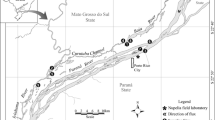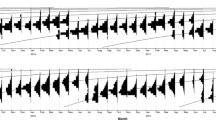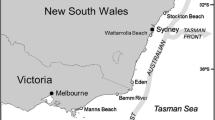Abstract
Despite the high global invasion profile of Gambusia holbrooki, there is limited knowledge of its population dynamics, especially biological parameters for fine-scale delineation of recruitment events that can provide a basis for controlling this short-lived invasive species. Key to this is daily ageing of otoliths, and in this study 193 (~ 50%) of 394 wild fish sampled from an invaded wetland were successfully aged. Increment counts of growth rings in otoliths from aquaria-reared G. holbrooki did not correspond 1:1 to their known ages but were significantly correlated (P < 0.05, R2 = 0.92), suggesting the use of linear relationships could nevertheless be used to estimate the age of wild-caught fish. Mean daily growth rate estimated for spring-summer cohorts (0.28 mm/day) was much greater than that of winter cohorts (0.12 mm/day). A natural mortality rate of 0.01 day− 1 for females was estimated by catch-curve analysis via length to age conversion based on the growth relationship. Birth rate closely correlated with changes in water temperature with a peak reproduction in January (Austral summer) at the study site. This study, for the first time, used daily age estimates of G. holbrooki to quantitatively examine population dynamics, which can be used to investigate invasive dynamics and choice of pest control strategies, including their scheduling and assessment.








Similar content being viewed by others
References
Arthington AH, Lloyd LN (1989) Introduced poeciliids in Australia and New Zealand. In: Meffe GK, Snelson FFJ (eds) Ecology and evolution of livebearing fishes (Poeciliidae). Prentice-Hall, Inc., Englewood Cliffs, pp 333–348
Beverton RJH (1957) On the dynamics of exploited fish populations. H. M. Stationery Off., London
Brown P, Walker TI (2004) CARPSIM: stochastic simulation modelling of wild carp (Cyprinus carpio L.) population dynamics, with applications to pest control. Ecol Model 176:83–97.https://doi.org/10.1016/j.ecolmodel.2003.11.009
Cabral JA, Marques JC (1999) Life history, population dynamics and production of Eastern mosquitofish, Gambusia holbrooki (Pisces, Poeciliidae), in rice fields of the lower Mondego River Valley, western Portugal. Acta Oecol 20:607–620. https://doi.org/10.1016/S1146-609X(99)00102-2
Campana SE, Jones CM (1992) Analysis of otolith microstructure data. In: Stevenson DK, Campana SE (eds) Otolith microstructure examination and analysis. Canadian Special Publication of Fisheries and Aquatic Sciences, vol 117, Canada, pp 73–100
Carmona Catot G (2013) Explaining the invasive success of the eastern mosquitofish (Gambusia holbrooki): the role of temperature. Dissertation/Thesis, Universitat de Girona
Cerna F, Plaza G (2016) Daily growth patterns of juveniles and adults of the Peruvian anchovy (Engraulis ringens) in northern Chile Marine. Freshw Res 67:899–912. https://doi.org/10.1071/MF15032
Chilton DE, Beamish RJ (1982) Age determination methods for fishes studied by the groundfish program at the pacific biological station. Department of Fisheries and Oceans, Ottawa
Constantz GD (1984) Sperm competition in Poeciliid fishes. In: Smith RL (ed) Sperm competition and the evolution of animal mating systems. Academic Press, Orlando.
Davies PE (2012) An assessment of the risks of gambusia infestation in Tasmania [Report to NRM North, Tasmania]
Diggle J, Patil J, Wisniewski C (2012) A manual for carp control: The Tasmanian model PestSmart Toolkit publication. Invasive Animals Cooperative Research Centre, Canberra, Australia 28
Dougherty AB (2008) Daily and sub-daily otolith increments of larval and juvenile walleye pollock, Theragra chalcogramma (Pallas), as validated by alizarin, complexone experiments. Fish Res 90:271–278. https://doi.org/10.1016/j.fishres.2007.10.021
DPI NSW (2018) New South Wales Department of Primary Industry website. New South Wales DPI. https://www.dpi.nsw.gov.au/fishing/pests-diseases/freshwater-pests/species/gambusia. Accessed 20 Apr 2018
Erguden SA (2013) Age, growth, sex ratio and diet of eastern mosquitofish Gambusia holbrooki Girard, 1859 in Seyhan Dam Lake (Adana/Turkey). Iran J Fish Sci 12:204–218
Gutierrez JB et al (2012) Analysis of the Trojan Y chromosome model for eradication of invasive species in a dendritic riverine system. J Math Biol 64:319–340.https://doi.org/10.1007/s00285-011-0413-9
Gutierrez JB, Teem JL (2006) A model describing the effect of sex-reversed YY fish in an established wild population: the use of a Trojan Y chromosome to cause extinction of an introduced exotic species. J Theor Biol 241:333–341. https://doi.org/10.1016/j.jtbi.2005.11.032
Haynes JL, Cashner RC (1995) Life history and population dynamics of the Western mosquitofish: a comparison of natural and introduced populations. J Fish Biol 46:1026–1041. https://doi.org/10.1111/j.1095-8649.1995.tb01407.x
Hoffmann BD, Broadhurst LM (2016) The economic cost of managing invasive species in Australia. NeoBiota. https://doi.org/10.3897/neobiota.31.6960
ICES (2014) Workshop on micro increment daily growth in European anchovy and sardine (WKMIAS). In: 21–25 October 2013 Mazara del Vallo, Sicily. France, Europe
Jones CM (1992) Development and application of the otolith increment technique. In: Stevenson DK, Campana SE (eds) Otolith microstructure examination and analysis. Canadian Special Publication of Fisheries and Aquatic Sciences 117, Canada, pp 1–9
Keane JP, Neira FJ (2004) First record of mosquitofish, Gambusia holbrooki, in Tasmania, Australia: Stock structure and reproductive biology. NZ J Mar Freshwat Res 38:857–867
Keller K, Brown C (2008) Behavioural interactions between the introduced plague minnow Gambusia holbrooki and the vulnerable native Australian ornate rainbowfish Rhadinocentrus ornatus, under experimental conditions. J Fish Biol 73:1714–1729. https://doi.org/10.1111/j.1095-8649.2008.02045.x
King MG (2007) Fisheries biology, assessment, and management, 2nd ed. Blackwell Publishing, Oxford
Komak S, Crossland MR (2000) An assessment of the introduced mosquitofish (Gambusia affinis holbrooki) as a predator of eggs, hatchlings and tadpoles of native and non-native anurans. Wildl Res 27:185–189
Kupchik MJ, Shaw RF (2016) Age, growth, and recruitment of larval and early juvenile Atlantic croaker (Micropogonias undulatus), determined from analysis of otolith microstructure. Fish Bull https://doi.org/10.7755/FB.114.1.2
Laplanche C, Elger A, Santoul F, Thiede GP, Budy P (2018) Modeling the fish community population dynamics and forecasting the eradication success of an exotic fish from an alpine stream. Biol Cons 223:34–46. https://doi.org/10.1016/j.biocon.2018.04.024
Lowe S, Browne M, Boudjelas S, De Poorter M (2000) 100 of the World’s worst invasive alien species: A selection from the global invasive species database. The Invasive Species Specialist Group (ISSG) a specialist group of the Species Survival Commission (SSC) of the. World Conservation Union (IUCN), Auckland
Lynch KA (2008) Ecology, population genetics and risk assessment of the exotic mosquitofish, Gambusia holbrooki in Tasmania. University of Tasmania
Macdonald J, Tonkin Z (2008) A review of the impact of Eastern gambusia on native fishes of the Murray-Darling Basin. Arthur Rylah Institute for Environmental Research, Department of Sustainability and Environment, Victoria
Nicol S, Haynes TB, Fensham R, Kerezsy A (2015) Quantifying the impact of Gambusia holbrooki on the extinction risk of the critically endangered red-finned blue-eye. Ecosphere 6:art41. https://doi.org/10.1890/es14-00412.1
Norazmi-Lokman NH, Purser GJ, Patil JG (2016) Gravid spot predicts developmental progress and reproductive output in a livebearing fish. Gambusia holbrooki PLoS ONE 11:1–18. https://doi.org/10.1371/journal.pone.0147711
Patimar R, Ghorbani M, Gol-Mohammadi A, Azimi-Glugahi H (2011) Life history pattern of mosquitofish Gambusia holbrooki (Girard, 1859) in the Tajan River (Southern Caspian Sea to Iran. Chin J Oceanol Limnol 29:167–173.https://doi.org/10.1007/s00343-011-0110-y
Pen LJ, Potter IC (1991) Reproduction, growth and diet of Gambusia holbrooki (Girard) in a temperate Australian river Aquatic Conservation. Marine Freshw Ecosyst 1:159–172. https://doi.org/10.1002/aqc.3270010205
Pimentel D et al (2001) Economic and environmental threats of alien plant, animal, and microbe invasions. Agric Ecosyst Environ 84:1–20. https://doi.org/10.1016/S0167-8809(00)00178-X
Pyke GH (2005) A review of the biology of Gambusia affinis and G. holbrooki. Rev Fish Biol Fish 15:339–365. https://doi.org/10.1007/s11160-006-6394-x
Pyke GH (2008) Plague minnow or mosquito fish? A review of the biology and impacts of introduced gambusia species. Annu Rev Ecol Evol Syst 39:171–191. https://doi.org/10.1146/annurev.ecolsys.39.110707.173451
Ricciardi A, Rasmussen JB (1998) Predicting the identity and impact of future biological invaders: a priority for aquatic resource management. Can J Fish Aquat Sci 55:1759–1765. https://doi.org/10.1139/f98-066
Ruiz-Navarro A, Verdiell-Cubedo D, Torralva M, Oliva-Paterna FJ (2013) Removal control of the highly invasive fish Gambusia holbrooki and effects on its population biology: learning by doing. Wildlife Research 40:82–89. https://doi.org/10.1071/WR12172
Scalici M, Avetrani P, Gibertini G (2007) Mosquitofish life history in a Mediterranean wetland. J Nat Hist 41:887–900. https://doi.org/10.1080/00222930701325433
Sloterdijk H, James NC, Smith MKS, Ekau W, Weyl OLF (2015) Population dynamics and biology of an invasive population of mosquitofish Gambusia affinis in a temperate estuarine lake system. Afr Zool 50:31–40. https://doi.org/10.1080/15627020.2015.1021169
Srean P (2015) Understanding the ecological success of two worldwide fish invaders (Gambusia holbrooki and Gambusia affinis). Dissertation/Thesis, Universitat de Girona
Taylor AH, Tracey SR, Hartmann K, Patil JG (2012) Exploiting seasonal habitat use of the common carp, Cyprinus carpio, in a lacustrine system for management and eradication. Mar Freshw Res 63:587–597. https://doi.org/10.1071/MF11252
Vargas MJ, de Sostoa A (1996) Life history of Gambusia holbrooki (Pisces, Poeciliidae) in the Ebro delta (NE Iberian peninsula. Hydrobiologia 341:215–224. https://doi.org/10.1007/BF00014686
von Bertalanffy L (1957) Quantitative laws in metabolism and growth. Q Rev Biol 32:217–231
Acknowledgements
This project was funded by the Australian Research Council (ARC) Linkage Project (LP 140100428) and Inland Fisheries Service Tasmania. HN received a scholarship from the Australian Awards Scholarship program. Dr. Peter Cui (IMAS) provided valuable comments on the study. Special thanks to John Duggin and volunteers at TIWR for their dedication to obtaining temperature and capture data. Melanie Leef and Jon Schrepfer provided technical support.
Author information
Authors and Affiliations
Corresponding author
Additional information
Publisher’s note
Springer Nature remains neutral with regard to jurisdictional claims in published maps and institutional affiliations.
Rights and permissions
About this article
Cite this article
Nguyen, H., Bell, J.D. & Patil, J.G. Daily ageing to delineate population dynamics of the invasive fish Gambusia holbrooki: implications for management and control. Biol Invasions 23, 2261–2270 (2021). https://doi.org/10.1007/s10530-021-02504-9
Received:
Accepted:
Published:
Issue Date:
DOI: https://doi.org/10.1007/s10530-021-02504-9




